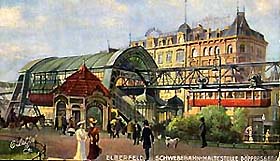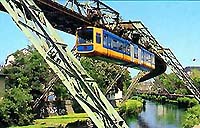 |
Suspended - Double Flanged
The Wupper River in northern Germany flows though a narrow valley, which was becoming urbanized and congested. Originally, an elevated railway was planned with the support pylons in the middle of the river, but public objections (NIMBYs!) and concerns about flooding scuttled that plan. Since the support for Langen's system would be on the banks and not in the river, and the fact that the cars could swing up to 15 degrees like a pendulum, the system was approved. The first part of the system opened in 1901 and the full 8.3 miles (13.3 km) with 20 stations opened in 1903. The original two car trains weighed 34 (31 metric) tons loaded with 97 passengers. 19,000 tons of iron were used to build the railway framework. The rails are supported by a total of 472 girders.
There are two dual-wheeled bogies per car. The double flanged steel wheels run on a single steel rail laid on a girder. Bogies on the original cars had a single motor using a chain to drive both wheels. Current cars use a single motor driving both wheels with worm gears. Reversing at each end of the line is by loop, and a turntable has been installed for short turns. In 1993, between 45,000 and 50,000 people used the Schwebebahn every day. Not bad for a system that's been around for nearly 100 years!
The Schwebebahn had a perfect safety record until 1999. On
April 12th, 1999, one of the Wuppertal trains fell off its track
and plunged into the river below. For the first time in the 98
year history of the Schwebebahn, five people died and 47 were
injured. The accident was caused when a contractor that was working
on the guideway accidentally left a metal clamp on it. This was
not a defect in equipment nor normal operating procedures. Countless
people have lost their lives in the last 100 years in train and
light rail accidents. Monorail still enjoys an enviable safety
record!
|
 The first successful use of monorail
technology in urban transportation was the Schwebebahn (suspended
or floating railway) of Wuppertal, Germany. It has been in operation
since 1901. Carl Eugene Langen gets credit for the concept, though
Albert Charlier had built the "schwebe bicycle" in 1895.
The first successful use of monorail
technology in urban transportation was the Schwebebahn (suspended
or floating railway) of Wuppertal, Germany. It has been in operation
since 1901. Carl Eugene Langen gets credit for the concept, though
Albert Charlier had built the "schwebe bicycle" in 1895.





